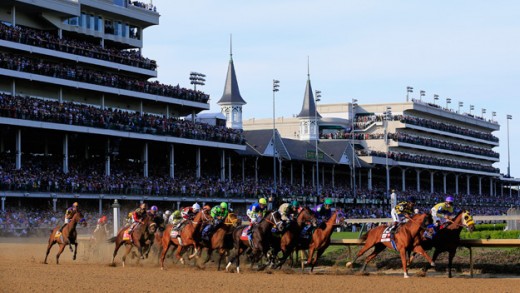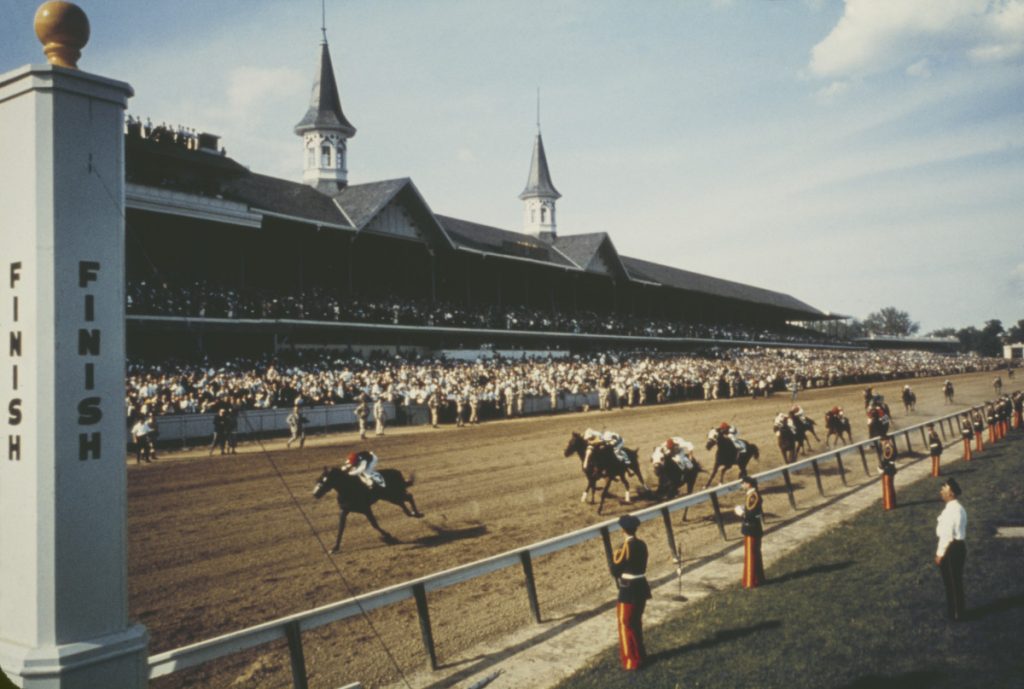There are not many American games with the history and
prevalence of the Kentucky Derby. It’s rich conventions – tasting a mint julep,
wearing a wonderful cap, and joining individual race fans in singing “My
Old Kentucky Home” – rise above the Kentucky Derby from only a game,
making it a festival of southern culture and a genuine symbol of Americana. The
Kentucky Derby is the longest running game in the United States, going back to
1875. The race is regularly alluded to as “The Run for the Roses®”
and has ceaselessly delivered “the most energizing two minutes in
sports”; continuous, in any event, while agreeing with significant
chronicled occasions like The Great Depression and World Wars I and II.
The Kentucky Derby’s long history started in 1872, when Meriwether Lewis Clark, the grandson of William Clark – of the popular pair Lewis and Clark – made a trip to Europe. While there, Clark went to the Epsom Derby in England, a notable pony race run since 1780, and furthermore associated with the French Jockey Club, a gathering that built up another mainstream horse race, the Grand Prix de Paris Longchamps. Clark was motivated by his movements and encounters, and, upon his arrival, was resolved to make a scene horse hustling occasion in the States. With the assistance of his uncle’s John and Henry Churchill, who skilled Clark the vital land to build up a circuit, and by officially arranging a gathering of nearby race fans to be named the Louisville Jockey Club, Clark and his new club raised assets to fabricate a perpetual course in Louisville, Kentucky. On May seventeenth, 1875, the circuit opened its entryways and the Louisville Jockey Club supported the absolute first Kentucky Derby. A sum of fifteen three-year-old Thoroughbred ponies hustled one and a half miles before a cheering horde of roughly 10,000 observers. Aristides was the main victor of the Kentucky Derby.

Similarly as with any significant occasion, the Kentucky
Derby has experienced different changes throughout three centuries. From
shortening the separation of the race, the presentation of customs like hanging
the triumphant pony in a wreath of roses, to the developing size of Derby
swarms, the Kentucky Derby has grasped the difference in time, while regarding
the respectability of the display race set out by Meriwether Lewis Clark.
Follow the timetable underneath to see exactly how far the Kentucky Derby has
come since 1875. You’ll find out about uncommon occasions throughout the entire
existence of the Kentucky Derby, as incredible pony exhibitions, record-setting
race realities and huge changes in the festival of the Kentucky Derby.
1874 – Colonel Meriwether Lewis Clark frames the
Louisville Jockey Club and procures land for course from his uncles John and
Henry Churchill.
1875 – The main Kentucky Derby race happens on May
seventeenth. Aristides races 1.5 miles to win, in a field of fifteen ponies,
before a horde of 10,000 observers.
1883 – Leonatus wins the Derby, and the name
“Churchill Downs” is first used to milestone the course that is the
home of the Kentucky Derby.
1889 – Bookmakers request that Colonel Clark evacuate
pari-mutuel wagering machines, since they are cutting into the bookmakers
benefits. Spokane wins the Derby.
1894 – Due to the developing group size, a 285-foot show
off is built to suit race fans. Serenade wins the Derby.
1895 – The renowned Twin Spires welcome the Kentucky
Derby swarm, on May sixth. Halma wins the Derby.
1896 – It is felt that the separation of the Derby race
is unreasonably long for multi year old Thoroughbreds that right off the bat in
the spring, so the separation of the Derby race is abbreviated from one and a
half miles to one and a quarter miles. Ben Brush wins the Derby, and he gets a
decorative layout of white and pink roses.
1899 – Founder of the Kentucky Derby, Colonel Meriwether
Lewis Clark, ends it all on April 22, 1899, only twelve days before the 25th
running of the Kentucky Derby, where Manuel wins.
1903 – Now under the initiative of Colonel Matt J. Winn,
the course praises its first benefit after the Kentucky Derby on May second
where Judge Himes wins the race.
1904 – The red rose turns into the official blossom of
the Kentucky Derby and Elwood wins the race.
1908 – The utilization of pari-mutuel betting machines is
reestablished, and bookmakers are banned. The Derby day swarm wagers an
aggregate of $67,570 of which $18,300 is put on the Derby race alone. Stone
Street wins the Derby.
1911 – The base wager is diminished from $5 to $2, and a wagering stall is presented. Two men are positioned in a stall to get fans’ wagers – one sells the betting ticket, and the different works a clicker to represent the quantity of tickets sold. Meridian successes the Derby.

1913 – The charges to enter a pony in the Derby and the
Derby winning prize cash are rebuilt. The new charges are $25 to choose a pony
for the Kentucky Derby and $100 for the pony to really run in the race. With
those gathered expenses, in addition to Churchill Downs adding $5,000 to the
satchel, the triumphant pony gets $5,475. Donerail wins the Derby, and turns
into the longest shot to win. He pays $184.90 to win wagers, $41.20 to put down
wagers, and $13.20 to show wagers.
1914 – Old Rosebud wins the Derby and sets another reputation,
completing the race in 2:03:04 and eight lengths in front of the second spot
finisher.
1915 – For the third sequential year, the Kentucky Derby
sprinkles the news, as the primary filly, Regret, wins the race. This exposure
builds up the Kentucky Derby as a chief game in America, after its 41st
running.
1919 – Sir Barton wins the Derby and is additionally the
main champ of what might turn into the Triple Crown of Thoroughbred Racing. In
the range of only 32 days, Sir Barton won the Kentucky Derby, the Preakness
Stakes, the Withers Stakes, and the Belmont Stakes.
1922 – Mor Vich wins the Derby and, notwithstanding the
triumphant satchel, he gets a gold smorgasbord administration piece including a
cup and candles. The prize is esteemed at $7,000 and is the main Derby
introduction of its sort. 1924 – Black Gold successes the 50th running of the
Kentucky Derby, and he gets a trophy, precisely like the one displayed today.
1925 – The primary system radio station of the Kentucky
Derby happens on May sixteenth, with around 5 to 6 million audience members
checking out hear Flying Ebony win the Derby. Likewise, outstanding in the
year, the expression “Run for the Roses®” is begat by Bill Corum, a
games editorialist for the New York Evening Journal and the New York Journal –
American.
1930 – Gallant Fox wins the Derby, and the term Triple
Crown is authoritatively utilized by the New York Times to portray his joined
successes in the Kentucky Derby, the Preakness Stakes, and the Belmont Stakes.
1931 – The Kentucky Derby is for all time planned for the
main Saturday in May, instead of an unsure date in mid-May. The move was to a
great extent because of the prominence of the possibility of a Triple Crown
champ, and took into consideration a predictable hustling plan for ponies that
would take an interest in the three races – The Kentucky Derby, trailed by the
Preakness Stakes, trailed by the Belmont Stakes.
1932 – Despite the Great Depression, the Kentucky Derby
race keeps on occurring and has a lot to celebrate. The race is globally
communicated, arriving at England’s British Broadcasting Company, and the
victor, Burgoo King, is the primary Kentucky Derby champ to be hung in a laurel
of red roses.
1938 – A passage is developed under the circuit that
associates the show off, onlooker seats to the field inside the course, called
the “infield”. Confirmation is 50 pennies to appreciate the Derby
from the infield. Lawrin wins the Derby and he is the first to take to a stand
worked in the infield for the official introduction to the Kentucky Derby
winning pony.
1943 – Regardless of the war-time travel limitations from
World War II and no away tickets offered to the Kentucky Derby, 65,000 fans
accumulate at Churchill Downs to see Count Fleet effectively rout the field at
2-5 chances.
1949 – The 75th Kentucky Derby is locally broadcast just
because, and Ponder wins the Derby.
1952 – The open introduction of the Kentucky Derby is
extended with the first national live TV inclusion in quite a while history. An
expected 10 to 15 million watchers check out watch Hill Gale win the Derby.
1954 – The Kentucky Derby winning handbag surpasses
$100,000, and Determine is the pony to trade out.
1966 – The renowned “Moguls Row” lounge area is
presented, and Kauai King wins the Derby.
1968 – Dancer’s Image is the principal Derby champ to be
excluded. Following the race, Dancer’s Image tried positive for an illicit
medicine, so the satchel is taken from him, and granted to the second-place
finisher Forward Pass, who is announced the victor.
1970 – Diane Crump is the principal female racer to ride
in the Kentucky Derby race. Crump completed fifteenth out of 18 ponies in the
field; and despite the fact that her Derby race wasn’t a success, she carried
ladies to the front line of pony dashing. Residue Commander wins the Derby.
1973 – In the 99th running of the Kentucky Derby,
Secretariat wins with the quickest completing time to date. Secretariat
finished the race in 1:59:40, and proceeded to win the Triple Crown, without
precedent for a long time.
1974 – The second biggest group in the historical
backdrop of U.S. Pure blood dashing watches Cannonade win the 100th Derby.
There were a sum of 163,628 fans at Churchill Downs to watch the race, which
additionally had a record enormous field size of 23 ponies.
1977 – Seattle Slew wins the Kentucky Derby and proceeds
to win the Triple Crown. He is the tenth Triple Crown champ, and the main pony
to take that title while likewise undefeated.
1978 – Affirmed wins the Kentucky Derby and proceeds to
win the Triple Crown.
1984 – The Kentucky Derby is simulcast at 24 circuits the
country over, permitting those racetr